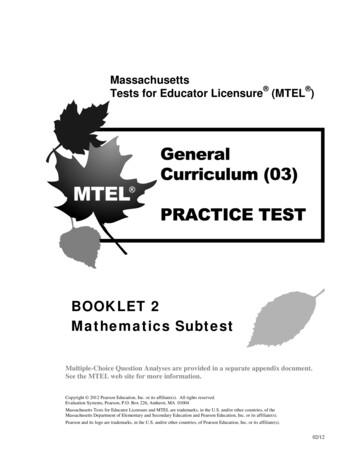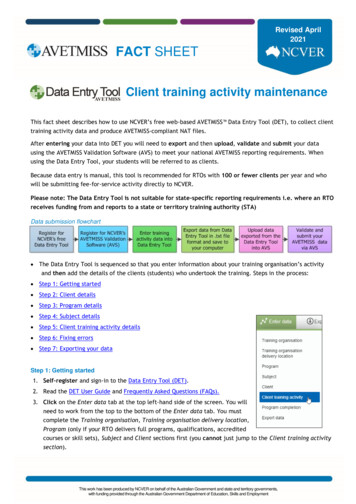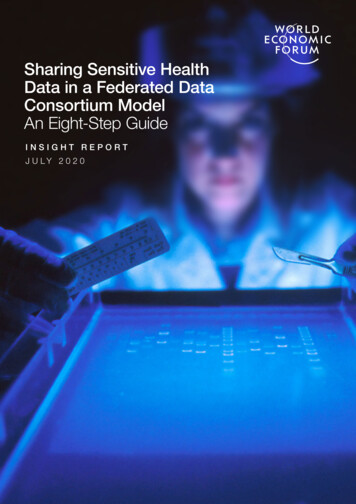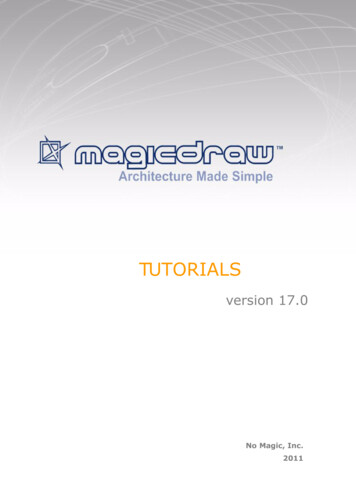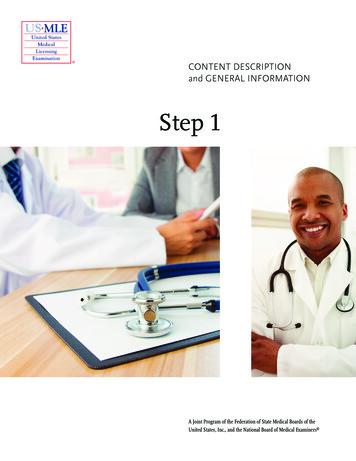
Transcription
CONTENT DESCRIPTIONand GENERAL INFORMATIONStep 1A Joint Program of the Federation of State Medical Boards of theUnited States, Inc., and the National Board of Medical Examiners
This booklet updated February 2018.Copyright 2018 by the Federation of State Medical Boards of the United States, Inc. (FSMB), and theNational Board of Medical Examiners (NBME ). All rights reserved. Printed in the United States ofAmerica. The United States Medical Licensing Examination (USMLE ) is a joint program of the FSMB andthe NBME.1
CONTENTSIntroduction . 3Examination Format . 3Purpose and Design of the Examination . 3Content Description and Content Outline . 4Test Specifications: Systems and Processes . 5Test Specifications: Physician Tasks/Competencies . 6Step 1 MCQ Content and Competency Examples . . 72
IntroductionExamination FormatThis booklet is intended to help you prepare forthe Step 1 component of the United StatesMedical Licensing Examination (USMLE ).Step 1 consists of multiple-choice questionsprepared by examination committees composedof faculty members, teachers, investigators, andclinicians with recognized prominence in theirrespective fields. Committee members areselected to provide broad representation from theacademic, practice, and licensing communitiesacross the United States and Canada.The information in this booklet, sample testmaterials and tutorials, and other informationalmaterials are available on the USMLE website(http://www.usmle.org).In addition to the information in this booklet, youshould review relevant sections of the USMLEBulletin of Information.Step 1 is a one-day examination. It is divided intoseven 60-minute blocks and administered in one8-hour testing session. The number of questionsper block on a given examination form will vary,but will not exceed 40. The total number of itemson the overall examination form will not exceed280.Sample test materials are available at the USMLEwebsite, in both a web-based interface withtutorials and as sample items in a booklet. Youmust run the tutorial and sample materials tobecome familiar with the test software prior toyour test date. The tutorial provided at thebeginning of the Step 1 examination has fewerscreens and less detailed information than thetutorial available as part of the Step 1 practicematerials on the USMLE website.Purpose and Design of the ExaminationThe Step 1 examination is designed to measurebasic science knowledge. Some questions test theexaminee’s fund of information per se, but themajority of questions require the examinee tointerpret graphic and tabular material, to identifygross and microscopic pathologic and normalspecimens, and to solve problems through theapplication of basic science principles.In addition, the practice materials on the websiteinclude items with associated audio or videofindings. You should become familiar with thesetypes of test items before your test date.Please monitor the USMLE website(http://www.usmle.org) announcements section tocheck for changes in the test delivery softwareand to access updated practice materials. Youmust obtain the most recent information beforetaking any USMLE examination.3
Content DescriptionThe content description that follows is not intended as a curriculum development or study guide. It providesa flexible structure for test construction that can readily accommodate new topics, emerging contentdomains, and shifts in emphasis. The categorizations and content coverage are subject to change. Broadlybased learning that establishes a strong general understanding of concepts and principles in the basicsciences is the best preparation for the examination.Content OutlineAll USMLE examinations are constructed from an integrated content outline, available on the USMLEwebsite ), which organizes content according to generalprinciples and individual organ systems. Test questions are classified in one of 18 major areas, depending onwhether they focus on concepts and principles that are important across organ systems or within individualorgan systems.Sections focusing on individual organ systems are subdivided according to normal and abnormal processes,including principles of therapy. Each Step 1 examination covers content related to the following traditionallydefined disciplines: anatomybehavioral sciencesbiochemistrybiostatistics and ologyThe Step 1 examination also covers content related to the following interdisciplinary areas: aginggeneticsimmunologymolecular and cell biologynutritionWhile not all topics listed in the content outline are included in every USMLE examination, overall contentcoverage is comparable among the various examination forms that will be taken by different examinees foreach Step.Most organ systems are partitioned into Normal Processes and Abnormal Processes and includesubcategories of specific disease processes. In most instances, knowledge of normal processes is evaluatedin the context of a disease process or specific pathology. (See Table 1 on page 5.)4
Table 1. USMLE Step 1 Test Specifications Systems and Processes*SystemRangeGeneral Principles of Foundational Science**15% – 20%Organ System Immune System Blood & Lymphoreticular System Behavioral Health Nervous System & Special Senses Skin & Subcutaneous Tissue Musculoskeletal System Cardiovascular System Respiratory System Gastrointestinal System Renal & Urinary System Pregnancy, Childbirth, & the Puerperium Female Reproductive System & Breast Male Reproductive System Endocrine System60% – 70%Multisystem Processes & DisordersBiostatistics & Epidemiology/Population HealthSocial Sciences15% – 20%ProcessRangeNormal Processes†10% – 15%Abnormal Processes55% – 60%Principles of Therapeutics15% – 20%Other‡10% – 15%* Percentages are subject to change at any time. See the USMLE website (http://www.usmle.org) for themost up-to-date information.** The general principles category includes test items concerning those normal and abnormal processes thatare not limited to specific organ systems. Categories for individual organ systems include test itemsconcerning those normal and abnormal processes that are system-specific.† This category includes questions about normal structure and function that may appear in the context of anabnormal clinical presentation.‡ Approximately 10% to 15% of questions are not classified in the normal processes, abnormal processes, orprinciples of therapeutics categories. These questions are likely to be classified in the general principles,biostatistics/evidence-based medicine, or social sciences categories in the USMLE Content Outline.5
Physician Tasks/CompetenciesIn addition to being organized by organ system, the Step 1 exam is organized by physician tasks andcompetencies, as shown in Table 2. More information about the physician task and competency outline isavailable on the USMLE website (http://www.usmle.org/pdfs/tcom.pdf).Test items are constructed to assess one of the competencies listed below.Table 2. USMLE Step 1 Specifications: Physician Tasks/Competencies*CompetencyRangeMedical Knowledge/Scientific Concepts55% – 65%Patient Care: Diagnosis History/Physical Examination20% – 30% Laboratory/Diagnostic Studies Diagnosis Prognosis/Outcome7% – 12%Patient Care: Management** Health Maintenance/Disease Prevention PharmacotherapyCommunicationProfessionalism2% – 5%Practice-based Learning and Improvement4% – 8%* Percentages are subject to change at any time. See the USMLE website (http://www.usmle.org) for themost up-to-date information.** The Step 1 examination includes management questions in only the categories listed in this table. Itdoes not include questions related to clinical interventions, mixed management, or surveillance fordisease recurrence.6
Step 1 MCQ Content and Competency ExamplesExamples of MCQ items focused on each of the competencies and a sampling of topics from differentareas of the content outline are shown below.Competency: Medical Knowledge/Scientific Concepts: Applying foundational science conceptsContent Area: Cardiovascular SystemA 65-year-old man is brought to the emergency department 30 minutes after the onset of acute chest painat rest that radiates to his left arm. His pulse is 110/min, respirations are 20/min, and blood pressure is150/80 mm Hg. Physical examination shows diaphoresis. The lungs are clear to auscultation of the chest.An ECG shows a new left bundle branch block. The tentative diagnosis of acute coronary syndrome ismade. Treatment with oxygen via nasal cannula, oral aspirin, and sublingual nitroglycerin, followed by anintravenous dose of a β-adrenergic blocker, is begun. Which of the following sets of changes is mostlikely to occur in this patient after the intravenous dose?Heart RateNo changeNo changeNo changeNo aseddecreasedincreaseddecreaseddecreasedMyocardial ecreasedincreaseddecreasedAnswer: GCompetency: Patient Care: Diagnosis: Laboratory and diagnostic studiesContent Area: Gastrointestinal SystemA 14-year-old girl has had nausea, intermittent diarrhea, and a 2.2-kg (5-lb) weight loss over the past 4 weeks.Examination shows a migrating serpiginous pruritic perianal rash. Her leukocyte count is 8000/mm 3 with20% eosinophils. Which of the following tests is most likely to yield an accurate diagnosis?(A)(B)(C)(D)(E)Blood smearBone marrow biopsyKOH preparationMicroscopic examination of the stoolSkin snipAnswer: D7
Competency: Patient Care: DiagnosisContent Area: Renal/Urinary SystemA 28-year-old man comes to the physician because of a 1-year history of pain with urination that has increased inseverity during the past month. He also has had episodes of blood in his urine during the past 5 years. He lived insub-Saharan Africa until he came to the USA 6 months ago for graduate school. His temperature is 38 C (100.4 F),pulse is 80/min, respirations are 16/min, and blood pressure is 110/84 mm Hg. Physical examination showssuprapubic tenderness. Laboratory studies show:HemoglobinHematocritLeukocyte countSegmented umUrea nitrogenCreatinineUrineBloodRBCWBCRBC castsWBC casts12.3 g/dL37%13,400/mm365%5%5%22%3%75 mg/dL3.8 mg/dL3 200/hpf100/hpfabsentabsentImaging studies show bilateral hydroureter and hydronephrosis and foci of calcification in the region of the bladder.A biopsy specimen of the bladder shows marked chronic inflammation with fibrosis and scattered granulomas.Which of the following best explains the biopsy findings?(A)(B)(C)(D)(E)Exposure to a chemical toxinInterstitial cystitisMalacoplakiaSchistosomiasisVesicoureteral refluxAnswer: D8
Competency: Patient Care: Management: PharmacotherapyContent Area: Hematopoietic and Lymphoreticular System: Adverse effects of drugsA 55-year-old woman with small cell carcinoma of the lung is admitted to the hospital to undergo chemotherapy.Six days after treatment is started, she develops a temperature of 38 C (100.4 F). Physical examination shows noother abnormalities. Laboratory studies show a leukocyte count of 100/mm3 (5% segmented neutrophils and 95%lymphocytes). Which of the following is the most appropriate pharmacotherapy to increase this patient's thasoneFilgrastimInterferon alfaInterleukin-2 (IL-2)LeucovorinAnswer: CCompetency: Practice-based LearningContent Area: BiostatisticsA study is designed to evaluate the feasibility of acupuncture in children with chronic headaches. Sixty children withchronic headaches are recruited for the study. In addition to their usual therapy, all children are treated withacupuncture three times a week for 2 months. Which of the following best describes this study design?(A)(B)(C)(D)(E)(F)Case-controlCase seriesCrossoverCross-sectionalHistorical cohortRandomized clinical trialAnswer: BCompetency: ProfessionalismContent Area: Social SciencesA 45-year-old man comes to the physician for HIV testing. He says that he has been having an extramarital affairwith a woman for 6 months, and he hopes this affair will continue because it has made him very happy. He has noplans to tell his wife about the affair. The wife is also a patient of the physician. Physical examination shows noabnormalities, and the result of a serum HIV antibody test is negative. Which of the following is the mostappropriate action by the physician?(A)(B)(C)(D)(E)Alert the local public health department to the patient's activitiesExplain to the patient that one of them must tell the wife about the affair for her own safetyRefer the patient for counselingSay nothing about the affair to anyone other than the patientTell the patient's wife about the affair so she can make an informed decision about possibly being placed atrisk in the futureAnswer: D9
3 Introduction This booklet is intended to help you prepare for the Step 1 component of the United States Medical Lice



